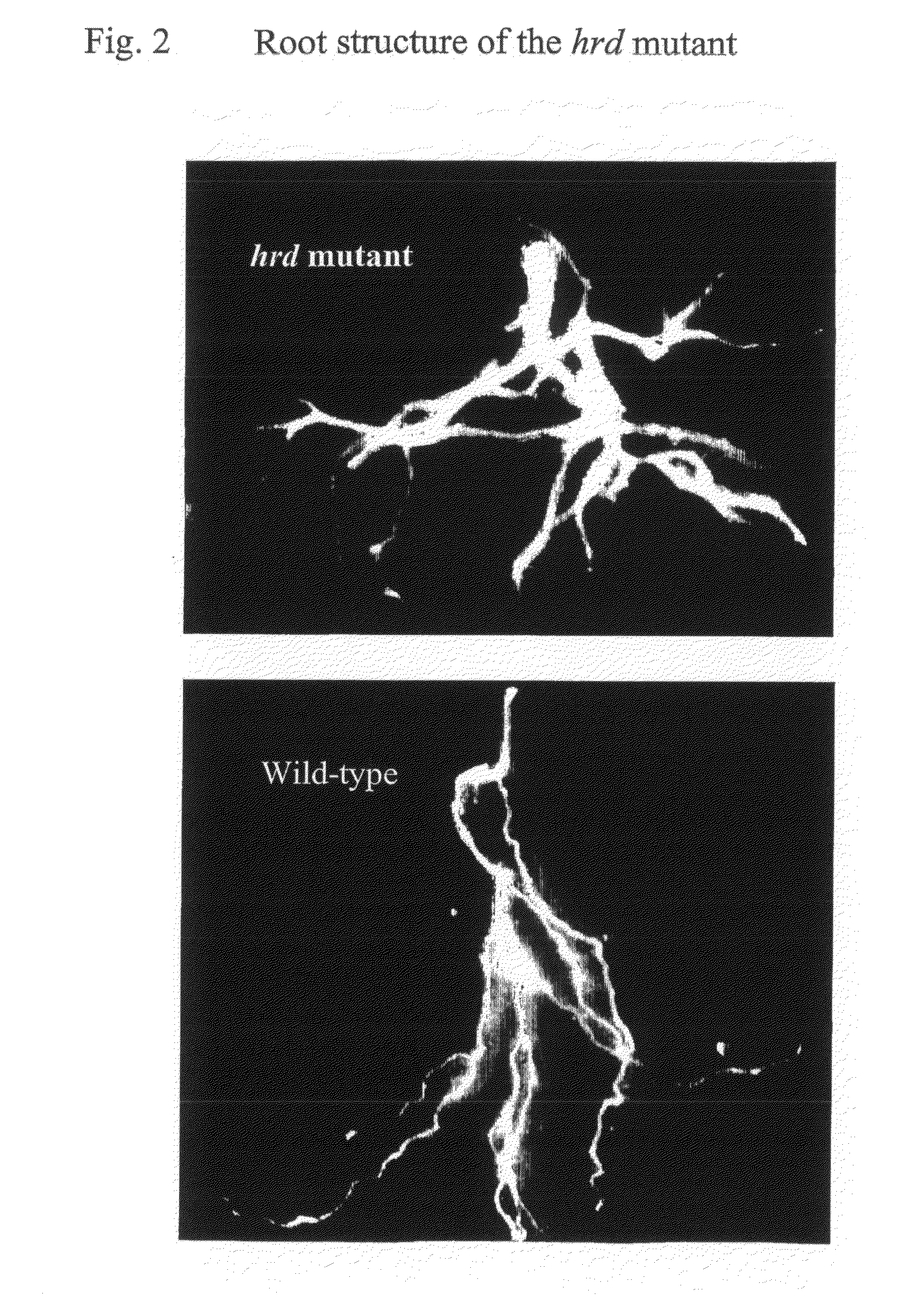Transgenic Plant Having Enhanced Drought Tolerance
a technology of drought tolerance and transgenic plants, applied in the direction of peptide sources, bio chemistry equipment and processes, etc., can solve the problems of reducing the growth and productivity of plant crops, thwarting traditional breeding, and constantly challenging plants
- Summary
- Abstract
- Description
- Claims
- Application Information
AI Technical Summary
Benefits of technology
Problems solved by technology
Method used
Image
Examples
example 1
Material and Methods
[0131]1.1 Plant Material and Drought Tolerance Experiment
[0132]All plants, including the activation tag population (Marsch-Martinez et al., 2002, Plant Physiol. 129: 1544-1556) and transgenic lines were grown in the greenhouse at around 22° C. and were in the Arabidopsis ecotype Wassilewskija (Ws).
[0133]For the drought experiments the activation tagged mutant hardy was compared with the rd29A-DREB-1A line (providing drought tolerance; Kasuga et al., 1999), both in the Arabidopsis ecotype Ws. The experiment was conducted in the greenhouse at 22° C., the plants grown in a soil mixture comprised one part of sand and perlite and two parts of compost (a mixture made up of 25% clay and 75% turf with EC ¼ 1 [nitrogen, phosphorous, and potassium]; Hortimea, Elst, The Netherlands). Seeds were sown (after three nights at 4° C.) at density of six plants per 4-cm pot in a tray with 51 pots (Aracon containers; BetaTech, Gent, Belgium). Nutrients (Hydroagri, Rotterdam, The Net...
example 2
Identification of the Hardy Mutant and Characteristic Phenotype
[0158]By screening a collection of 2000 Arabidopsis transposon activation tag lines (Marsch-Martinez et al., 2002) a mutant plant was identified with slow growth and dark green leaves. Both rosette and cauline leaves of the mutant (termed hardy, hrd) had thicker leaves when compared to wild type plants. The mutant was later in flowering and had reduced seed set. The most striking phenotype was that it was difficult to pull the mature plant from the soil, presumably due to a strong root structure. The plants seemed very tolerant to changes in the greenhouse conditions thus having the name hardy. Progeny analysis of the self-pollinated hrd mutant line suggested a dominant mutation (three quarters of the plants exhibited the hrd phenotype).
[0159]The segregating mutant plants showed difference in their growth pattern and size ranging from medium looking plants to very small plants. The medium sized plants bolted at the same ...
example 3
An AP2 / ERF Transcription Factor Gene is Responsible for the hrd Mutant Phenotype
[0162]DNA gel blot analysis showed that hrd contains a single insertion (data not shown). Isolation and sequence analysis of DNA flanking the insertion site further indicated that the insertion is located in an intergenic region on chromosome 1 (FIG. 3A). The location of the 35S enhancer tetramer is between a gene encoding an unknown protein (4025 base pairs upstream of the promoter) and a gene encoding a member of the plant specific AP2 / ERF family of transcription factors (620 base pairs upstream of the promoter). To examine if these two genes were induced in expression in hrd compared to wild type, we conducted a Reverse Transcription PCR(RT-PCR) experiment using cDNA isolated from hrd and wild type leaf tissues (FIG. 3B).
[0163]The results showed that only the AP2 / ERF gene AT2g36450 at 6 kb distance from the 35S enhancer tetramer was induced in the hrd mutant leaves compared to wild type leaves and was...
PUM
| Property | Measurement | Unit |
|---|---|---|
| Tm | aaaaa | aaaaa |
| temperature | aaaaa | aaaaa |
| pH | aaaaa | aaaaa |
Abstract
Description
Claims
Application Information
 Login to View More
Login to View More - R&D
- Intellectual Property
- Life Sciences
- Materials
- Tech Scout
- Unparalleled Data Quality
- Higher Quality Content
- 60% Fewer Hallucinations
Browse by: Latest US Patents, China's latest patents, Technical Efficacy Thesaurus, Application Domain, Technology Topic, Popular Technical Reports.
© 2025 PatSnap. All rights reserved.Legal|Privacy policy|Modern Slavery Act Transparency Statement|Sitemap|About US| Contact US: help@patsnap.com



